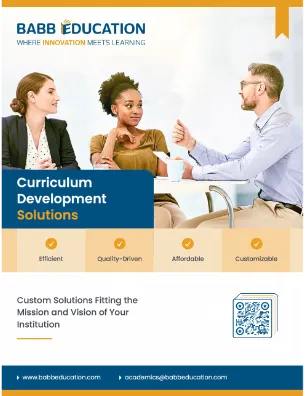One of the most effective strategies we've employed to boost student engagement is active learning.
As Director of eLearning at Babb Education, I've had the privilege of working with a dedicated team of instructional designers who are passionate about creating dynamic and engaging online learning experiences. One of the most effective strategies we've employed to boost student engagement is active learning. By incorporating interactive elements such as discussions, group work, and hands-on activities, we can transform a passive learning environment into a vibrant, participatory one.
Understanding Active Learning
Active learning is a pedagogical and andragogical approach which involves engaging students directly in the learning process. Rather than passively receiving information, students participate in activities designed to promote analysis, evaluation, and synthesis of content. The active learning approach is grounded in the belief that learning is more effective when students are actively involved in constructing their own knowledge.
The Importance of Active Learning in Online Courses
Online courses present unique challenges for student engagement. Without the physical presence of a traditional classroom, maintaining students' attention and motivation level can be difficult. Active learning addresses these challenges by fostering a sense of community and collaboration among students; it encourages them to take an active role in their education, making the learning experience both more meaningful and memorable.
Best Practices for Incorporating Active Learning
Interactive Discussions
Discussions are a fundamental component of active learning. In an online setting, discussion forums can serve as a platform for students to engage with each other and with the course material. To maximize the effectiveness of online discussions, consider the following strategies:
- Structure Prompts: Provide clear, thought-provoking prompts designed to encourage critical thinking and reflection. Write questions students can answer from their personal and/or professional experience in addition to the weekly learning content. Avoid questions that can be answered with a simple yes or no as these do little to stimulate robust academic discussions. Also, remember to include a “lead-in” which is a paragraph or two setting the context for the question. Real or hypothetical examples along with current events can make for interesting lead-ins!
- Guide Participation: Set expectations for participation in the discussion forum. For example, many schools require students to write an initial post in response to the discussion question and two responses to initial posts from their peers for each week of the course.
- Incorporate Response Posts: When students can respond to their peers’ initial posts, they are honing their critical thinking skills and their ability to provide meaningful and honest feedback; both of which will serve them well in their personal and professional life. Ideally, these opportunities also help students foster collaboration. Creating a brief list of response prompts is also helpful. For example, you can ask students to respond by sharing an experience, posing a question, citing additional sources, or offering specific feedback. Be sure to include guidelines for respectful and constructive feedback and actively monitor and facilitate discussions to keep them on track.
Collaborative Group Work
Group work is another powerful tool for active learning. It promotes teamwork, communication, and problem-solving skills. Here are some tips for assigning group work in online courses effectively:
- Write Clear Objectives: Defining clear objectives and outcomes for group projects helps to ensure students understand the purpose of the activity and what they are expected to achieve.
- Form Diverse Groups: When groups with diverse skill sets and perspectives work with each other, it can enrich the learning experience. Be sure to encourage students to leverage each other’s strengths.
- Encourage Groups to Establish Roles and Responsibilities: When faculty empower each group to make decisions about specific roles (group leader, note-taker, researcher, presenter, etc.) and responsibilities, rather than assigning them, group members are more likely to feel invested in the work and the success of the team. This approach fosters a sense of accountability, as members are responsible for their chosen roles and are more likely to commit to achieving the group's objectives.
- Schedule Check-ins: Scheduling a few check-ins with groups throughout the term is a good idea for monitoring their progress, addressing issues, clarifying learning content, and providing feedback. Check-ins help to keep group projects on track and ensure all members are contributing.
Hands-On Activities
Hands-on activities, such as simulations, case studies, and interactive labs provide students with practical experience and real-world application of concepts. These activities can be particularly engaging and memorable. Consider these ideas for hands- on activities:
- Craft Authentic Scenarios: Designing activities that simulate real- world scenarios relevant to the course content can help students see the practical implications of what they are learning.
- Write Clear, Step-by-Step Instructions: Providing clear, step-by-step instructions for completing the activity, including resources, helps ensure students can successfully navigate the tasks.
- Incorporate Opportunities for Reflection: Incorporating opportunities for reflection helps students hone their ability to be self- aware and self-reflective. When students can analyze their experience, discuss what they learned, and connect it to the course material, they are deepening their understanding of both themselves and the course content.
Utilize Technology
Technology enhances active learning by providing tools and platforms for interaction and collaboration. Here are some ways Babb Education instructional designers leverage technology in online courses:
- Utilize the Learning Management Systems (LMS): Utilize the features of your LMS to create interactive content, manage discussions, and track student progress. You can also use tools like quizzes, surveys, and polls to engage students.
- Use Video Conferencing: Video conferencing allows for live discussions, virtual office hours, and group meetings; this adds a personal touch to the online learning experience and helps establish a collegial and community-oriented environment.
- Create Interactive Media: Developing interactive multimedia assets such as videos, animations, games, and simulations can make academic content come to life which is more engaging for students and can also lead to higher retention rates. H5P, Articulate 360, and many other authoring tools, are great to use for creating interactive elements within course materials.
Foster a Supportive Learning Environment
The active learning approach demands a supportive learning environment. All students need to feel safe and encouraged to take academic risks, share ideas, and participate fully in their learning. Here are some strategies to create such an environment:
- Ensure Inclusive Practices: Promote inclusivity by acknowledging and valuing diverse perspectives. Ensure all students have an equal opportunity to participate in, and contribute to, the learning.
- Give Positive Feedback: Providing frequent constructive and positive feedback aimed at encouraging growth and development is a building block of creating a supportive learning environment. By highlighting successes and offering supportive guidance, you are creating a positive learning environment where students feel valued and driven to excel; this not only enhances their current performance but can also foster a lifelong love for learning.
- Open Communication: Encourage open communication between students and instructors. Create channels for students to ask questions, seek help, and provide feedback. Give students reminders about the benefits of vising their instructor during office hours.
Active learning is a powerful approach to enhancing student engagement in online courses. By incorporating interactive discussions, collaborative group work, hands-on activities, and leveraging technology, we can create a dynamic and participatory learning environment. At Babb Education, our best practices for instructional design are centered around these principles, ensuring that students are not just passive recipients of information, but active participants in their learning journey.
As we continue to explore and refine active learning strategies, we remain committed to working closely with faculty to design innovative and effective online courses. Together, we can create educational experiences that are engaging, meaningful, and transformative for students.
Contact Babb Education today to learn more about how our instructional designers can help you create an engaging and supportive learning environment for your students through using the active learning approach.



